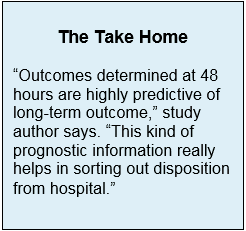Key Points:
- Researchers use ESCAPE trial data to chart stroke severity over time
- NIHSS score at 2 days foretells mRS score at 90 days
Early improvement following treatment for acute ischemic stroke is highly predictive of long-term functional outcome, according to an analysis published online December 6, 2016, in Stroke.
Michael D. Hill, MD, of the University of Calgary (Calgary, Canada), and colleagues used data from the ESCAPE trial to compare the accuracy of early, serial longitudinal National Institutes of Health Stroke Scale (NIHSS) measurements with other early markers of stroke severity posttreatment at predicting subjects’ 90-day stroke outcome.
NIHSS scores were assessed at baseline and again at 1, 2, 5, 30, and 90 days. Subjects’ functional outcome was assessed using the modified Rankin Scale (mRS) at baseline, 30 days, and 90 days.
Investigators identified 3 distinct trajectories of NIHSS score over the first 2, 5, and 30 days: large improvement (41.6%), minimal improvement (31.1%), and no improvement (27.3%). Patients in the large-improvement group were more likely to exhibit good outcomes after 90 days than those in the minimal improvement or no improvement subgroup.
Those with large improvements in NIHSS score were more likely to be younger (P = .02), have had a lower baseline NIHSS (P < .01), have fewer internal carotid artery occlusions (P < .01), and a better ASPECTS (P < .01). They were also more likely to have received endovascular treatment (P < .01) and intravenous tPA (P = .05).
At 84.5%, the 2-day NIHSS trajectory was more accurate at predicting 90-day outcome than were NIHSS score at baseline, at 24 hours, the change between baseline and 24 hours, and infarct volume. This pattern held true with and without adjustment for other baseline characteristics including age, sex, ASPECTS, baseline occlusion, and intravenous alteplase. The improvement in predictive value that occurred with the addition of 5 and 30 day NIHSS assessments was negligible.
Potential New Endpoint for Clinical Trials
“We show that much of the improvement in acute stroke treatment occurs in the first few days,” Dr. Hill told Neurovascular Exchange in an email. “Outcomes determined at 48 hours are highly predictive of long-term outcome. This kind of prognostic information really helps in sorting out disposition from hospital.”
In a telephone interview with Neurovascular Exchange, accompanying editorialist Italo Linfante, MD, of the Herbert Wertheim College of Medicine and Baptist Hospital (Miami, FL), extrapolated on this notion.
Currently, Dr. Linfante explained, most clinical trials depend on 90-day mRS to determine outcomes. If a highly reliable marker of outcome could be determined much sooner than 90 days, this would drastically increase the efficiency of clinical trials and reduce their cost. Serial NIHSS scores fit the bill perfectly, because they are easy to measure and, according to this analysis, are highly predictive of 90-day mRS when recorded over the first 48 hours.
“Hopefully,” he said, “we can replicate these data and use this instrument to reduce the number of patients we need to enroll in clinical trials,” what with less potential for losing them to follow-up over the 90-day time horizon.
Serial NIHSS scores can also be used clinically, he added, as a prognostic indicator and decision-making tool. They much easier and less expensive to obtain than other markers such as infarct volume MRI.
Sources:
Sajobi TT, Menon BK, Wang M, et al. Early trajectory of stroke severity predicts long-term functional outcomes in ischemic stroke subjects: results from the ESCAPE trial (Endovascular Treatment for Small Core and Anterior Circulation Proximal Occlusion with Emphasis on Minimizing CT to Recanalization Times). Stroke. 2016;Epub ahead of print.
Linfante I, Dabus G. Predicting outcomes in the era of endovascular therapy. Stroke. 2016;Epub ahead of print.
Disclosures:
- Dr. Hill reports receiving grants from Medtronic (Covidien).
- Dr. Linfante reports being a consultant for Medtronic, Stryker, and Penumbra.
